by Elana Harris, MD, PhD with Paul Horn, PhD, Akiva Kirschner, Jing Xiang, MD, PhD
Editor’s Note: We are excited to share the results of this investigation of brain waves in youth with OCD, which was funded by a donor-supported grant from the International OCD Foundation, as well as a K23 research grant from the National Institute of Mental Health (NIMH).
As a child and adolescent psychiatrist, I have seen firsthand that youth with OCD are often reluctant to share their symptoms and even to acknowledge that they have a disorder at all. In youth, as in adults, OCD symptoms are often overlooked or unnoticed by others or hidden by the patient. These factors present barriers to early detection and treatment of OCD in children, and are complicated by the lack of an objective test that can augment the questions clinicians ask their patients during clinical interviews. As a result, treatment is initiated in adolescents an average of two years after the first symptoms of the disorder begin to appear (Walitza et al., 2008).
BACKGROUND & RESEARCH GOALS
Brain waves are patterns of electrical activity in the brain that can be measured using specialized equipment, such as an electroencephalogram (EEG). Researchers have found detectable differences when looking at the brain wave patterns of people with mental health disorders like OCD and ADHD, compared to brain wave patterns observed in healthy individuals. The U.S. Food and Drug Administration has approved the use of an EEG, together with a clinical interview, to confirm a diagnosis of ADHD in children (Snyder et al., 2015), and EEG may also be used to better understand the course ADHD will take in these children (Arns et al., 2013). In these ways, brain waves are being used as a biomarker. In other words, they are something that we can detect in the body that has changed due to an illness and can be measured through a test.
Given the difficulty of diagnosing OCD in patients, particularly in children, and the limitations of clinical interviews (e.g., patients may choose not to disclose some or all of their symptoms), the potential for brain waves to be used as a biomarker in detecting OCD has attracted a lot of interest from researchers.
RESEARCH DESIGN OVERVIEW
Previous investigators looking for differences in brain waves compared adults with OCD to adults without OCD, and looked at brain wave patterns that repeat themselves slowly (from just a few times per second to up to 30 times per second). Their tests were conducted while the adults were awake and had their eyes closed, referred to as the “resting state.” These investigators found that the brain wave patterns that repeat themselves slowly were more powerful in individuals with OCD, and that the faster brain wave patterns that they measured were less powerful in individuals with OCD (Velikova et al., 2010; Pogarell 2006; Karadag et al, 2003; Tot et al., 2002). We decided to focus on even faster (or higher-frequency) patterns called gamma waves, which repeat themselves between 30 and 55 times per second. We did this because gamma waves support the higher cognitive functions that are relevant to the thoughts and obsessions of individuals with OCD. Our theory then, was that based on what we know about how OCD works in the brain, we expected to measure stronger gamma waves in youth with OCD than in typically developing youth. Additionally, we expected to find stronger gamma wave activity in individuals with OCD to be concentrated in the frontal parts of the brain.
Instead of using EEG equipment, we measured brain waves using a technique called magnetoencephalography (MEG). Using MEG had several advantages over EEG: it allowed for us to collect better data about the higher frequency brain waves that we wanted to study, and allowed us to collect data using a helmet instead of many individual electrodes attached to the head – an advantage with any group of patients, but particularly with children. Like researchers who studied adults with OCD, we measured brain waves in youth while they were in the “resting state” — awake with their eyes closed.
Our subjects were between the ages of 11 and 17, and were recruited from 2010 to 2016 from an academic outpatient hospital in the Midwestern United States through clinic referrals and emails sent to hospital employees. Written informed consent and assent were obtained from each parent and subject, respectively, prior to participation. Participants with OCD had a score of at least 15 on the Children’s Yale Brown Obsessive Compulsive Scale (CY-BOCS) indicating that they had at least moderate OCD symptoms. In total, we enrolled 10 children with OCD, and 10 typically developing children in the study. Eight of the 10 participants with OCD were in some form of treatment: two were receiving cognitive behavioral therapy with no medication, and six were being treated with a selective serotonin reuptake inhibitor (SSRI).
WHAT WE FOUND
To our knowledge, we are the first to have found differences in resting state gamma wave activity in symptomatic youth with OCD compared with typically developing youth. We found that gamma waves in youth with OCD were stronger in all regions of the brain — not just the frontal areas like we had hypothesized. Gamma waves in these children were stronger in every way we measured them: their minimum power, or baseline strength, was increased, as was their average power and maximum power.
Although gamma waves were stronger in all areas of the brain that we measured, we found that the most consistent differences between youth with OCD and typically developing youth were in the temporal lobe. Whenever we measured stronger gamma waves in this part of the brain, it was a consistent predictor that the individual being studied belonged to the group of youth with OCD.
At this stage, we aren’t sure exactly what is causing the stronger gamma waves we observed in individuals with OCD. Further research studies could examine connections in animal brain slices — a method of analysis that allows researchers to keep brain tissue alive for eight hours after the brain is removed — to better understand the underlying circuitry and its connection to gamma wave activity. Another approach would be to use computer simulations to model various neurotransmitter receptors that may be responsible for differences in gamma activity in children with OCD. This technique was used to identify a receptor that is less active in people with schizophrenia and is linked to increased gamma wave activity (Kirli et al., 2014). Computer modelling could help answer similar questions about the increased gamma activity we saw in OCD.
CONCLUSION
Our discovery may have revealed a new biomarker in gamma waves that can serve clinicians and patients as an objective measure of illness! Information about a patient’s gamma wave activity may give clinicians another layer of information on top of the responses they receive from patients during clinical interviews, and could prove useful as a tool for confirming an OCD diagnosis and predicting the course that the illness will take in that individual.
Unfortunately, magnetoencephalography (MEG) is an expensive tool; clinical charges for a session may run several thousand dollars and it is not yet approved by the FDA for use in OCD. However, progress is being made in the MEG field and costs may decrease as the system changes from being contained in a full room to being worn as a transportable helmet.
Future research should also explore the underlying differences between brain waves at both lower and higher frequencies in children. A better understanding of the brain activity that supports obsessions and compulsions could inform therapies like transcranial stimulation or deep brain stimulation. Further work on gamma waves may show that they can serve as a marker to predict treatment response to medication or therapy; they may also be measured throughout the course of OCD treatment, and be used to gauge whether a patient is responding.
As interest in the discovery of biomarkers grows, we are excited about what we have found through this study and the potential that it could hold for patients with OCD, particularly children. We are grateful for the funding support that we received from the IOCDF that helped make this study possible.
REFERENCES
Arns, M., C.K. Conners, and H.C. Kraemer, A decade of EEG Theta/Beta Ratio Research in ADHD: a meta-analysis. J Atten Disord, 2013. 17(5): p. 374-83.
Karadag, F., et al., Quantitative EEG analysis in obsessive compulsive disorder. Int J Neurosci, 2003. 113(6): p. 833-47.
Kirli, K.K., G.B. Ermentrout, and R.Y. Cho, Computational study of NMDA conductance and cortical oscillations in schizophrenia. Front Comput Neurosci, 2014. 8: p. 133.
Pogarell, O., et al., Symptom-specific EEG power correlations in patients with obsessive-compulsive disorder. Int J Psychophysiol, 2006. 62(1): p. 87-92.
Snyder, S.M., et al., Integration of an EEG biomarker with a clinician’s ADHD evaluation. Brain Behav, 2015. 5(4): p. e00330.
Tot, S., et al., Association of QEEG findings with clinical characteristics of OCD: evidence of left frontotemporal dysfunction. Can J Psychiatry, 2002. 47(6): p. 538-45.
Trevizol AP et al., Transcranial Magnetic Stimulation for Obsessive-Compulsive Disorder: An Updated Systematic Review and Meta-analysis. J ECT. 2016 Dec;32(4):262-266.
Velikova, S., et al., Dysfunctional brain circuitry in obsessive-compulsive disorder: source and coherence analysis of EEG rhythms. Neuroimage, 2010. 49(1): p. 977-83.Walitza, S., et al., Transmission disequilibrium studies in early onset of obsessive-compulsive disorder for polymorphisms in genes of the dopaminergic system. J Neural Transm (Vienna), 2008. 115(7): p. 1071-8.

